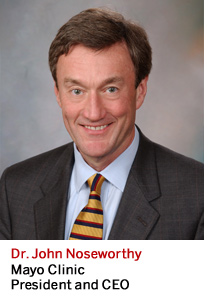Since it launched four years ago, the Mayo Clinic Care Network (MCCN) has expanded to include dozens of affiliated facilities in 18 states, Mexico, and Puerto Rico as part of a broader plan to maintain Mayo Clinic's position as a flagship U.S. medical institution, Dan Browning and Jackie Crosby write for the Minneapolis Star Tribune.
Background on the network
The field guide to hospital partnership and affiliation models
In September 2011, the Mayo Clinic created the MCCN as a way to expand its reach in an industry awash with consolidation. Through MCCN, Mayo affiliates with hospitals that it does not own, a key distinction from the Mayo Clinic Health System—which includes providers in about 70 communities in Iowa, Minnesota, and Wisconsin.
Organizations that join the network must fill out a 1,400-page application and pay a subscription to access Mayo's expertise and use Mayo's brand. However, the entities remain wholly independent. According to David Hayes, MCCN's medical director, the network helps Mayo "to have more of a reach and… structured links to a broader group of hospitals and medical centers throughout the country."
Altru Health System in Grand Forks, North Dakota, was the network's first member. Since then, the network has signed up 30 additional affiliates. Last year, Mayo reached seven million patients through its network. Overall, Mayo's reach as increased threefold; about 63 million people connect with the system for medical services, products, and lab tests or through social media platforms.
How member hospitals use the network
Matthew Roller, a neurologist and member of Altru's board of directors, says he uses e-consults frequently to send images, lab work, and clinical notes to Mayo specialists. The specialists respond by sending back "a well thought-out, examined, discussed opinion" on the patient's ailment, usually within two days. He says the program "has allowed a number of patients to stay at home and get an opinion, and allowed [hospitals] to manage patients with some of these subspecialty needs closer to home in an effective way."
The partnership is helpful even when Mayo specialists are unable to cure a patient. Angela Rackley, a doctor at Mayo partner St. Elizabeth Healthcare in Edgewood, Kentucky, remembers a time she could not solve a mystery illness ailing of one of her patients. She says, "I fe[lt] better knowing that the specialists at Mayo ha[d] taken a look at him and done the appropriate testing," adding, "It's nice to have someone who has a lot more knowledge in the field that you're treating."
Meanwhile, the Mayo brand has benefited from the partnership. Although members of the Care Network cannot use Mayo's logo, many partners prominently cite their association with the health care giant, increasing Mayo's notoriety in areas outside its Minnesota base.
CEO John Noseworthy says the expansion of its network is also a good way to spread Mayo's patient-centered model of care in a way that a merger or acquisition would not. He says, "The reason we didn't do the merger and acquisition strategy ... is that's really not scalable [and] it also doesn’t do anything for patient care."
What's next?
According to the Star Tribune, the network could position Mayo to develop mini-networks of hospitals focused on particular subspecialties—networks that could be attractive to large employers and health insurers. Mary Jo Williamson, chair of Mayo's Department of Practice Administration, says, "We could go to an employer or insurance company and say, 'We would be your preferred portion of the network.'"
The network is just part of Mayo Clinic's $5.6 billion plan to secure its place as a flagship U.S. medical center in an industry filled with consolidating organizations. Part of that plan focuses on transforming Rochester, Minnesota, into an international medical destination.
By 2020, Mayo aims to directly or indirectly reach as many as 200 million people (Browning/Crosby, Star Tribune, 12/8).
Mayo CEO John Noseworthy: Why Mayo Clinic's CEO wants to serve 200 million patients—and how he plans to do it

An excerpt from our interview with Dr. John Noseworthy, President and CEO of Mayo Clinic:
Question: You've spoken about an ambitious goal—by 2020, to have Mayo serving 200 million patients. At the same time, you're not taking a traditional M&A approach to grow your footprint.
Noseworthy: We want to optimize what Mayo Clinic has done for years: providing face-to-face care for people who are seeking hope and solutions. And in this very challenging environment, optimization on that level is no small order—we're focused like a laser on that.
Don't miss out on the latest Advisory Board insights
Create your free account to access 1 resource, including the latest research and webinars.
Want access without creating an account?
You have 1 free members-only resource remaining this month.
1 free members-only resources remaining
1 free members-only resources remaining
You've reached your limit of free insights
Become a member to access all of Advisory Board's resources, events, and experts
Never miss out on the latest innovative health care content tailored to you.
Benefits include:
You've reached your limit of free insights
Become a member to access all of Advisory Board's resources, events, and experts
Never miss out on the latest innovative health care content tailored to you.
Benefits include:
This content is available through your Curated Research partnership with Advisory Board. Click on ‘view this resource’ to read the full piece
Email ask@advisory.com to learn more
Click on ‘Become a Member’ to learn about the benefits of a Full-Access partnership with Advisory Board
Never miss out on the latest innovative health care content tailored to you.
Benefits Include:
This is for members only. Learn more.
Click on ‘Become a Member’ to learn about the benefits of a Full-Access partnership with Advisory Board
Never miss out on the latest innovative health care content tailored to you.
